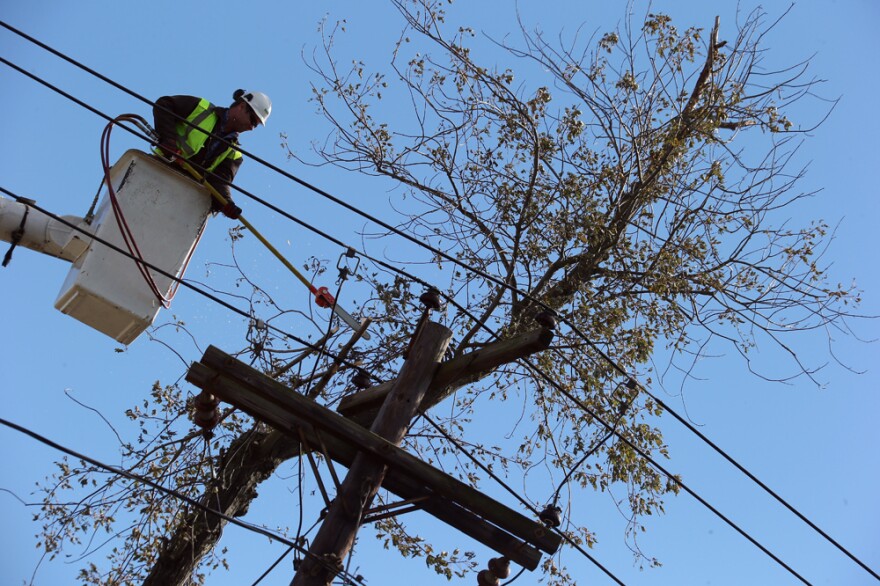Normally, the nor'easter bearing down on the Northeast on Wednesday wouldn't be a tremendous cause for concern. But the storm, delivering snow, sleet and wind gusts of up to 60 miles per hour, is expected to hit parts of Long Island and New Jersey still reeling from Hurricane Sandy.
More than nine days after Sandy hit, more than 200,000 Long Island residents are still waiting for the power to come back on. The Long Island Power Authority, already facing intense criticism from residents and state officials, has issued warnings that Wednesday's storm is likely to create new outages.
Sandy wreaked havoc on Long Island's power grid. "Restoring power is going to be one of the major challenges for us," said New York Gov. Andrew Cuomo at a press conference last week. "You have about 2 million families without power." Close to half of those families, he said, were Long Island residents.
But Patty Manfredonia, president of a volunteer ambulance company in Sayville, N.Y., lucked out.
"I am the lucky one who never lost power, so people can hate me all they want," she says. "I had friends showering and bathing here ... they were able to come here, charge up their phones and their computers. So that was one good thing."
Nonstop Calls For Help
Initially, people pulled together in Sandy's wake. The Long Island Power Authority, or LIPA, posted an outage map online. Little blue dots illustrated each place power was down, and hard hats showed where crews were working. Blue dots covered the map.
Manfredonia and her ambulance crew also saw an uptick in calls.
"We got a lot of respiratory [calls] during the hurricane, because people lost power and we had to take them to the hospitals to let them plug in or get oxygen," she says.

And calls like those haven't really stopped. Sunday night, an elderly woman turned off her generator and shut down her respirator to try to save gas. When she went to bed that night, Manfredonia says, she was unable to lie in bed because she was having so much trouble breathing. Crew member Chris Gonzales got the call and ran her to the hospital.
Patience Wanes
As of Monday, one week after Sandy hit, more than 300,000 people on Long Island still had no electricity — and patience was fading.
"It's getting frustrating, you know," says Matt Shatzer, a doctor who lives in Dix Hills. His area was not particularly hard-hit by the storm, but earlier this week he and his family were camping out at his sister's place.
"I appreciate that my family and I are OK, and my house is intact. But it's definitely getting very frustrating that we are on a week now of not having power," Shatzer says.
Long Island's power grid is almost entirely aboveground. The island is densely populated, but it's also heavily wooded, so when the wind blows hard — like during a nor'easter — power inevitably fails somewhere.
Sheldon Sackstein, the chairman of a county oversight committee that monitors the power authority, says the time has come "to start to underground this system."

A Utility Company Under Fire
But LIPA officials say burying all the wires could cost $30 billion. To complicate matters, this week, Moody's warned that the power authority was already in danger of running out of cash.
Cuomo has threatened to replace LIPA's management. Sackstein says he's been asking LIPA to show its emergency response manuals and plans for at least 18 months.
"So where do you point the finger? I'm not sure yet," he says, "But I'd certainly like to read those emergency preparedness manuals."
Manuals or no, Sackstein says it's obvious to him that LIPA wasn't prepared.
By Tuesday, Shatzer, the Dix Hills doctor, was upset not only that his family still lacked power but also that LIPA had taken down the maps indicating where the power was still out.
Turns out residents had noticed some big outages weren't represented on those maps, so LIPA then replaced it with one that offers a lot less detail.
Officials at LIPA say they are doing the best they can. They are grappling with the biggest storm in their history, they say, and another that has already arrived.
Copyright 2021 NPR. To see more, visit https://www.npr.org.






